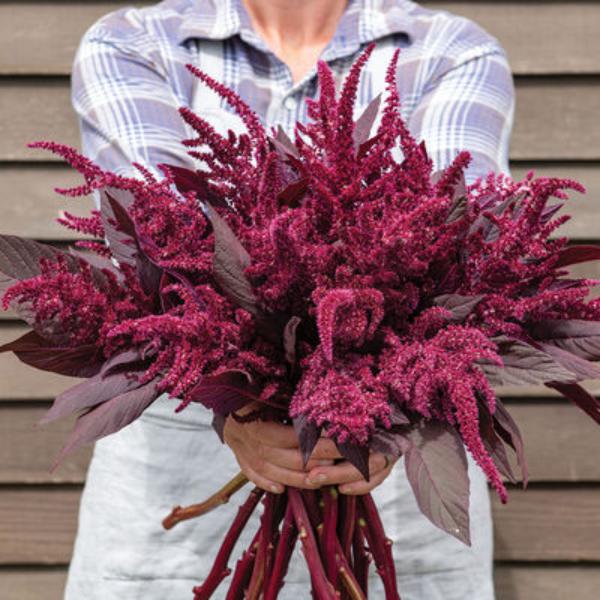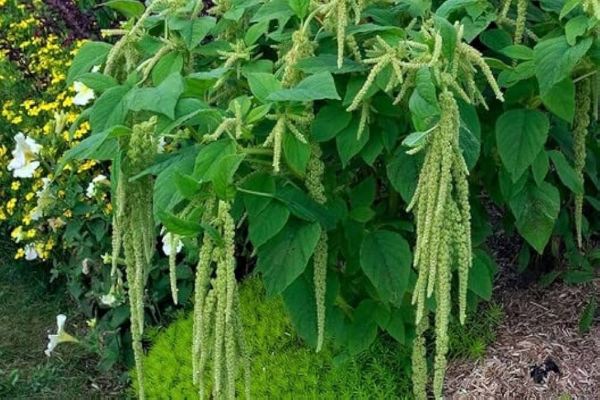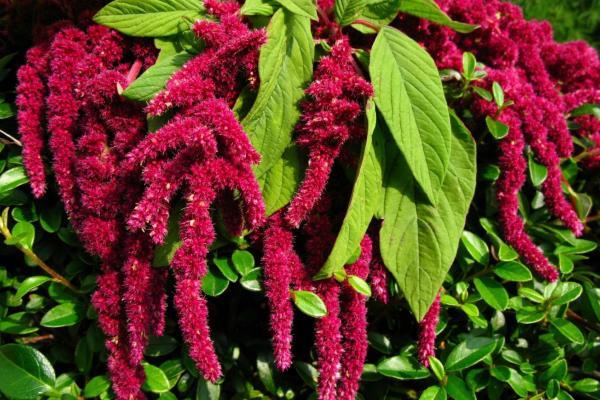Do you know what type of plant amaranthus is? Let’s have a brief discussion of this mesmerizing plant!
Amaranthus, commonly known as amaranth, is one of the underrated crops in our home garden. This plant belongs to the Amaranthacease family which contains over 60 species, some of which are cultivated as grains, leaf vegetables, and ornamental plants.
It is considered one of the staple foods of the Aztecs and Incas in pre-Columbian times. Similarly, amaranthus is recognized for its unique feature of rhombic leaves that have prominent veins, can be green or purple, and have long petioles.
It also produces vibrant and often colorful flowers, ranging from red to purple, green, or gold.
Amaranthus: Unveiling Its types and uses
As we already mentioned Amaranthus has many species and varieties, each with its characteristics and uses. Some species are cultivated as vegetables such as Amaranthus blitum, Amaranthus dubius, Amaranthus tricolor, Amaranthus lividus, and Amaranthus spinosus.

These species of leaves and stems are commonly eaten after cooking similar to spinach. Similarly, several species are grown as a grain crop including Amaranthus cruentus, Amaranthus hypochondriacus, and Amaranthus caudatus. These grain crops are also used to produce cereals and snacks.
Likely, several amaranthus are grown for ornamental or decorative purposes such as Amaranthus viridis, Amaranthus Retroflexus, Amaranthus hybridus, Amaranthus gracilis, and Amaranthus gangeticus.
Moreover, some amaranth species are regarded as weeds.
Can amaranth be used as a substitute for other grains?
Amaranth is an exceptional grain that often remains overlooked, despite its immense benefits. This ancient grain boasts a unique nutty and earthy flavor and can be utilized in many ways. For example, it can be popped like popcorn and sprinkled with some flavor for a nutritious snack. It can also be sprouted and mixed into salads for a protein boost, or added to bread and soup recipes to improve nutrition and flavor.
Exploring the Health Benefits of Growing Amaranthus
Amaranthus is a highly nutritious plant that offers numerous health benefits, making it an excellent choice for anyone looking to improve their diet. The lists below suggest how to include its positive health benefits into your diet in a flavorful and enjoyable way.
Nutrient-Rich Leaves
Amaranthus are indeed nutrient-rich and edible leafy vegetables that offer a wide array of health benefits. Its leaves are particularly rich in vitamins A, C, and K which help to robust immune function, promoting strong bones, and healthy vision. Besides, it has minerals like calcium, iron, and magnesium.
High in protein
Amaranthus seeds contain a moderate amount of protein which is essential for muscle repair, growth, and overall body function. Additionally, incorporating these protein-packed seeds into your diet can help meet your protein needs, especially for individuals following vegetarian or vegan diets.
Reduce weight loss
Amaranthus helps to reduce your weight due to its high fiber content and low-calorie density. The high fiber contained in amaranthus helps to reduce weight, promotes feelings of satiety, and prevents overeating. Additionally, it aids in digestion, lowers cholesterol, and promotes fullness.
Heart diseases
Amaranthus can help reduce the risk of heart disease thus it is rich in fiber which helps to maintain optimal cholesterol levels. Similarly, the presence of antioxidants in amaranthus helps to reduce inflammation and oxidative stress. By consuming amaranth, you can reduce the risk of chronic diseases such as heart disease, diabetes, and cancer.

Gluten-Free
Amaranth is a great grain substitute for persons who have celiac disease or are gluten-sensitive. It is naturally gluten-free, so it is a suitable option for those who cannot consume gluten. You can grind it into flour for baking, or use it as a substitute for grains in different recipes.
Antioxidant Properties
Amaranth is a highly nutritious grain that is rich in antioxidants. These antioxidants can fight against free radicals and reduce inflammation, thereby lowering the risk of chronic diseases. In addition, amaranth grain is packed with polyphenols and flavonoids, which are powerful antioxidants that help protect the body from oxidative stress.
Anti-inflammatory
Studies have shown that the peptides found in amaranth possess anti-inflammatory properties, which may help in reducing the risk of chronic inflammation-related diseases like arthritis and inflammatory bowel disease.
Supports a Healthy Pregnancy
Amaranth is a nutritious grain that is particularly beneficial for pregnant women as it is rich in folate, which aids in preventing birth defects. It is an excellent source of protein, calcium, fiber, vitamin C, and magnesium, making it an ideal food for pregnant and lactating women.
A complete guide to growing Amaranthus in your garden
Amaranth is a hardy plant that can thrive in various soil types and temperatures with minimal water needs. It is an excellent alternative crop because of its economic use of resources, especially in areas with poor soil quality or a threat of drought. In addition, amaranth is well-suited for organic farming practices, owing to its rapid growth and ability to outcompete as a grain, ornamental, leafy vegetable, or forage crop.
To ensure amaranthus optimal growth, it is important to follow a step-by-step guide.
Choose the right variety

Amaranth is a plant that comes in various varieties, each having its unique characteristics, such as leaf color, plant size, and seed color. When selecting a cultivar, you should consider your environment, the available space, and your intended purpose, whether it be for leaves, seeds, or ornamental purposes.
Select Location
After that, choosing the best location to grow amaranthus is very important. Look for an area with rich, well-draining soil that receives full sunlight. It required at least 6-8 hours of direct sunlight per day. Similarly, make sure the soil in the area is rich in organic matter and drains well to avoid waterlogging, which can lead to root rot.
Prepare the Soil
As mentioned previously, amaranthus does not thrive in waterlogged soil. Therefore, it is essential to prepare the soil by loosening it to a depth of approximately 12 to 18 inches. Using composted organic matter or manure can significantly improve soil fertility, leading to more robust growth of the plant.
Sowing
When you are prepared to plant amaranthus seeds, ensure that you sow them at a depth of 1/4 to 1/2 inches. Before planting, make sure that the soil temperature is warm enough for the seeds to germinate. Furthermore, each seed should be spaced four to five inches apart. Following planting, gently water the soil to settle it.
Watering
Watering is another essential factor to consider that helps to keep soil moisture. To promote root growth, it is important to give water frequently. However, make sure to keep the soil consistently moist but not waterlogged.
Pests and Diseases
Amaranthus is generally resistant to pests and diseases. However, under some conditions, it may be vulnerable to aphids, flea beetles, and powdery mildew. So, you must regularly monitor your plants for any signs of pests or diseases such as discoloration or unusual growth. If you notice any signs, you should take appropriate action, such as handpicking, spraying with insecticidal soap, or applying fungicides, to control the infestation.
FAQs
1. What are the different types of amaranthus?
Amaranthus plant belongs to the Amaranthacease family which contains over 60 species, some of which are cultivated as grains, leaf vegetables, and ornamental plants.
2. Why should I grow amaranthus in my garden?
Amaranth is a hardy plant that can thrive in various soil types and temperatures with minimal water needs. Similarly, it is well-suited for organic farming practices, owing to its rapid growth and ability to outcompete as a grain, ornamental, leafy vegetable, or forage crop.
3. How does growing amaranthus contribute to health?
Amaranthus are indeed nutrient-rich and edible leafy vegetables that offer a wide array of health benefits. It helps to reduce your weight due to its high fiber content and low-calorie density. Similarly, it is naturally gluten-free, so it is a suitable option for those who cannot consume gluten.
Also read, How to plant and grow Bush Honeysuckle
